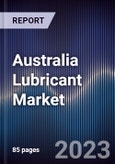Market Overview:
The lubricant market in Australia was showing steady growth and significant potential. Lubricants play a crucial role in various industries. Strong delivery network accompanied by authorized distributors to reach out to customers through both online and offline modes led to an increase in the overall sales of lubricants in the Australia. Up-scaling Manufacturing Industry, Escalating Construction, Automotive and Marine Industries are major growth drivers for Australia Lubricants Market. Bio-lubricants and lubricants with reduced fuel consumption are the major trends among end users in Australia Lubricants Market.Market is expected to witness an increase in the consumption of lubricants due to rapid growth in industrialization and infrastructural developments, rising private and government investments; cost effective manufacturing operations
Lubricants Industry concentration is at a moderate level, with the four largest companies estimated to account for ~40% of industry revenue in 2022-23.
Australia Lubricant Market Analysis
The Australia lubricant market was significant in terms of value and volume. It experienced steady growth due to increasing industrial activities, the expanding automotive sector, and infrastructure development projects.The industrial segment was one of the primary drivers of lubricant demand in Australia. Various industries, including manufacturing, mining, construction, agriculture, and marine, heavily relied on lubricants for the smooth functioning of machinery and equipment.
The automotive industry, particularly the increasing number of vehicles on the road, was a significant contributor to the lubricant market. The need for automotive lubricants was driven by regular vehicle maintenance and the growth of the vehicle fleet.
Advancements in lubricant technology, particularly the development of synthetic lubricants with superior properties, impacted the market. These advanced lubricants offered improved performance, efficiency, and extended equipment life.
Key Trends by Market Segment:
By Type of Lubricant: The boosting sales of automobiles in the country have significantly led to the increased consumption of automotive lubricants than industrial lubricants. The increased sales were also supported by the continuous improvement in the refining process of the existing players and the upgradation of refineries by the lubricant’s giants operating in the country.By Distribution Channel: Most of the lubricants consumed by the industrial sector of the Australia have been supplied by the widespread network of authorized and local distributors across various regions of the Australia. Distributors might be dealing in a particular brand or can have multiple brands of lubricants that are used for industrial purposes. Distributers are in direct contact with the company, thus creating the trust among the customers to buy genuine products from them.
Competitive Landscape:
The competitive landscape of the lubricant market in Australia was dynamic and competitive, with both domestic and international companies operating in the market. The industry attracted various players offering a wide range of lubricant products and services. Please keep in mind that the competitive landscape may have changed since then, so it's crucial to refer to more recent sources for the latest information. In Australia’s Lubricants Market, there many players operating in the overall market, and the top 5 players accounted for more than half share in the market in terms of revenue. The major parameters on which these players complete include product portfolio, distribution network, clientele, partnerships, product pricing, and more.Recent Developments:
BP has a number of subsidiaries and retail brands that include Amoco; ARCO; BP Express, BP Connect; BP Travel Centre; AM/PM; Burmah Castrol, etc., which provide the company with a diversified revenue portfolio rather than simply relying on its energy business.Australia's expanding industrial sectors, including manufacturing, mining, construction, and agriculture, contributed to the demand for lubricants. Infrastructure development projects also drove the need for lubricants in construction and maintenance activities.
The automotive sector was a major consumer of lubricants in Australia. The market experienced changes due to the increasing popularity of electric vehicles (EVs) and hybrid vehicles, which could influence the demand for specific types of lubricants tailored for these new vehicle technologies.
Similar to the global trend, the lubricants market in Australia was witnessing a growing emphasis on environmentally friendly lubricants. This includes a demand for bio-based lubricants and those with lower environmental impact to align with sustainability goals.
Future Outlook:
Increasing production and sales of light commercial vehicles as well as heavy duty vehicles, primarily for trade transport is expected to propel demand for automotive lubricants across Australia in the coming years.Additionally, growth in automotive repair services market across the country coupled with rising adoption of synthetic and semi-synthetic lubricants is further anticipated to fuel growth in Australia automotive lubricants market during the forecast period.
The automotive industry is shifting towards electric and hybrid vehicles, which have different lubrication needs compared to traditional internal combustion engines. This transition could impact the types and volumes of lubricants required in the market.
Innovations in lubricant formulations, such as synthetic and high-performance lubricants, could influence market dynamics. These advancements could be driven by the need for greater efficiency, extended equipment lifespan, and reduced maintenance costs.
Additional benefits of purchasing an enterprise license:
- TAM/SAM/SOM Analysis
- Customer Cohort Analysis
- Marketing Initiatives
- White Space Opportunity Analysis
- Interactive Data Visualizations
- Customization: 20 Analyst Hours
- 3 Months Post Sales Analyst Support
- Complimentary Update Next Year
- Custom Webinars
Table of Contents
Companies Mentioned (Partial List)
A selection of companies mentioned in this report includes, but is not limited to:
- Castrol
- Shell (Viva Energy)
- Exxon Mobil
- Chevron
- Total Energies
- PenriteShell
- Castrol
- Chevron (Caltex)
- Fuchs








